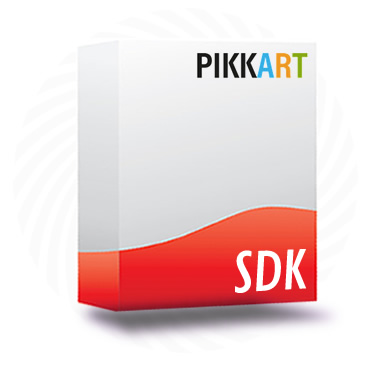Unity 3D Plugin >
AR Logo
This tutorial will guide you through the creation of an AR application able to recognize ARLogo images and prints. This tutorial starts from the project created in the Local Planar Marker Unity tutorial. Our SDK is designed to work with Unity3D 5+ and support both iOS and Android.
ARLogo is a Pikkart proprietary technology that allows you to create multiple “versions” of the same image (marker) by adding an invisible code detectable by our SDK. This allows developers to create multiple augmented reality experiences on the same image. The ARLogo detection is on-device and thus does not need an internet connection. For more details visit the ARLogo page.
The recognition of the ARLogo code starts right after the detection of a marker, and this means that there’s a short period of time (usually less than a second) between the detection of the marker and the recognition of the ARLogo.
To give an immediate response to the user, we will show a placeholder content during this period of time. For this reason we are going to create a simple 3D object to be shown when the marker is detected, but no ARLogo has been already recognized.
To use the ARLogo technology on a marker created on the CMS, make sure to check the “enable ARLogo” checkbox. Then download and use the resulting .dat marker file in your app.
Adding the Pikkart ARLogo recognition in a Unity project is very simple.
Delete the markers in the folder “StreamingAssets/markers”. Go to “Assets->Import Package->Custom Package” and import the marker in the Unity Tutorial ARLogo archive.
Delete all the markers in the Unity scene and place four new empty markers, your unity scene should look like this:
Now assign to all the markers the same marker id (If no marker id appears in the list, press on the Import Markers button)
By changing the “Marker ARLogo Pattern” property of a marker we can select the ARLogo that will be assigned to the specific marker in the unity scene. The code -1 means no ARLogo, and the connected 3D content will be shown in the period of time between the detection of the marker and the recognition of the ARLogo codes.
Now set the Marker ARLogo pattern of the four markers to the following values: 65266, 84895, 97703 and -1. Place four different 3D objects on the markers, for example from the Sample->prefabs folder that comes with the Unity sample assets package (that should be already imported in your Unity project).
We thus have three markers that react to ARLogo prints, and one for the generic scene with no ARLogo (in the example scene we put a simple gray 3D cube).
Your scene should look like this:
Now you are ready to start the app, using File->Build & Run to deploy it on an Android device. You can try recognizing the provided ARLogo images inside the Unity Tutorial ARLogo archive or try your own markers if you created them with our CMS.
